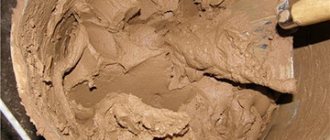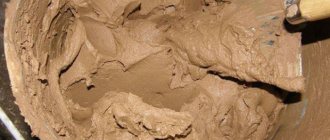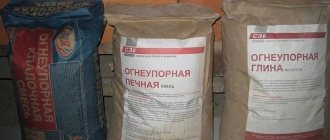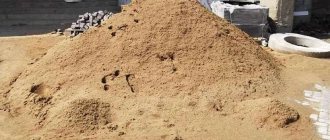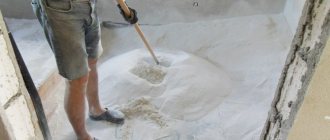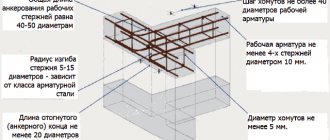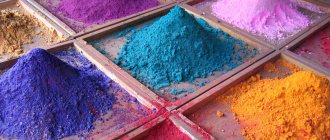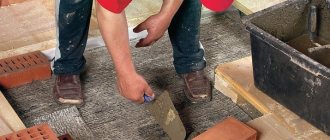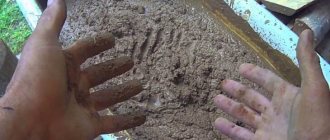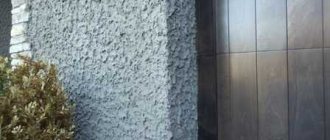Well-built stove serves for decades and does not require major repairs.
When creating such devices, several types of mortar are used: clay, lime, lime-cement and cement . Sand is added to all mixtures.
The main part (body) of the furnace is often laid out using clay mortar; craftsmen use cement mortar for the foundation . Cement or lime-based mixtures are suitable for chimneys Inside the chimney, less condensation (soot) is deposited on the limestone lining. You can prepare oven mixtures yourself or buy them at a hardware store.
Cement mortar for laying a brick oven
Stove makers use it for the foundation and chimney rising above the roof. This type of masonry does not get wet from water. Cement has increased strength; it is not afraid of not only atmospheric, but also soil moisture that appears at the base of the house during long rains and melting snow.
Photo 1. Pouring the foundation for building a furnace using cement.
Compound
Several brands of Portland cement are suitable for preparing the mixture: M 300, M 400, M 500 . Cement is sold in bags of 25 and 50 kg , after purchase it is mixed with sand. For work, use only fine-grained sand with a particle diameter of 1.5 mm or less . Sand collected in a quarry requires cleaning, which includes the following steps:
- Manual selection of large stones, crushed stone, pebbles, plant debris and roots.
- Sifting the material through a metal sieve with a cell diameter of 1.5 mm .
- Sand washing . For this procedure, a net is made from a linen burlap stretched over a frame. A small amount of raw material is placed in it and water is poured from a hose, which is supplied under pressure. Dust and clay particles come out of the material. Continue washing until the water becomes clear.
Reference. Quartz sand or sand of mixed composition (containing quartz, feldspars, and other solid minerals) is suitable for preparing the masonry mixture
Manufacturing: procedure and proportions
The masonry mixture, in addition to cement, includes sand and water . To work, you need a large container (tank, trough, bath). In order to knead the ingredients you need a wooden or metal spatula or a construction mixer . Large volumes of cement, sand and water are prepared in a concrete mixer . For different brands of cement, different amounts of sand are used:
- 1 measure of cement M 500 and 3 measures of sand;
- 1 measure of cement M 400 or M 300 and 2.5 measures of sand.
Fireclay sand and fireclay crushed stone are needed for preparing mixtures with increased heat resistance. Similar solutions are used in laying the bottom of the combustion chamber and the walls of the firebox. The mixtures include:
- cement grades M 300 or M 400 - 1 measure ;
- fine-grained sand and broken bricks (fireclay crushed stone) - 2 measures ;
- 0.3-0.5 measures of fireclay or regular sand.
Stove makers use tap, melt, river or spring water. It should be “soft” ; a high content of mineral salts will lead to white marks and streaks . They also appear on the chimney after heavy rains.
Procedure for preparing cement-sand mortar:
- The calculated amount of cement and sand is poured into the container .
- Mix the ingredients with a spatula.
- Pour water into the mixture and mix the mass in a concrete mixer or construction mixer. Manual mixing with a spatula is allowed if the volume of the solution is small.
When choosing materials, you should focus on their quality . Caked, lumpy, long-stored cement, unsifted and unwashed sand are not suitable for mixing.
What to do if the mixture has dried out
, resembles natural stone in strength . It cannot be dissolved by water or chemicals . When the mixture hardens, water enters the cement structure and gives it high strength.
If the frozen mass is broken and ground, the result is a powder similar to the original cement; the material loses its qualities and becomes unsuitable for such important work as laying the base and chimney of a furnace.
To completely restore cement with the removal of bound water, special factory equipment is needed . This process takes place at high temperatures, and it is impossible to carry out it yourself at home.
Important! At an air temperature of 20 degrees, the cement begins to “set” after 2 hours . At a temperature of 30 degrees, the mass hardens faster (in 1-1.5 hours ).
The mixture is too thin or thick
If the cement-sand mass is too thick, add water to the container in small portions and mix the contents . If there is a lot of water in the mixture, it is made thicker by adding calculated portions of dry cement and sand (for example, add 1 measure of cement and 3 measures of sand at the same time ).
Reference. The quality of the cement-sand paste is checked using a trowel. A correctly made solution does not flow or fall off in pieces from its working surface when tilted at 45 degrees .
Construction compounds made using cement and water cannot be stored . Intensive stirring helps slow down the hardening process.
We make a free foundation from stone and clay. Or you can do it without clay at all, but it’s just as durable
Well, we have seen a total increase in prices for all building materials, and significantly. So, how should a budget country homeowner proceed? If a couple of years ago it was possible to build a house for 1 million, today even two is not enough. And this is without finishing; I’m generally silent about finishing and arrangement.
Well, I wrote about this in one of the previous publications, so there is no point in repeating myself. But it makes sense to consider what it is possible to build a country house from today at least at the prices of the year before last? Are there any other building materials that have not risen in price?
Since I have divided this problem into several main parts (foundation, walls, roof, insulation), then in each of these parts I will consider each part separately. And let's start with the foundation. First briefly, and then in more detail.
For the construction of the foundation, we have long been using cement, sand, water and reinforcement, not counting some other little things like additives, however, their weight in the overall construction is insignificant. Our water has not become more expensive, but the fittings have begun to cost 2-3 times more than 2 years ago. But the mass of reinforcement in the foundation is not so significant for a novice developer; for some reason, the main cost for him is cement and sand. And even without taking into account the rise in price, concrete costs too much money - about 200 thousand rubles. Is this a lot or a little? And what if we add reinforcement, which in reality, that is, in total, will cost almost the same?
This is approximately how much concrete costs for us, and this is without delivery. This is approximately how much concrete costs for us, and this is without delivery.
Do you think a budget developer will bear such costs?
Of course, a frame house can be placed on piles, which will somewhat reduce the cost of the foundation, but what if the house is made of aerated concrete? Even if you use piles, such a foundation will still cost no less than a strip foundation. But this is only hypothetically, because a normal specialist would not recommend putting a stone house on piles to anyone. Well, especially me.
Map of soil freezing depth in Russia. According to the indicated value, strip foundations should be deepened, because even the most insulated blind area will not save from frost heaving Map of the depth of soil freezing in Russia. According to the indicated value, strip foundations should be deepened, because even the most insulated blind area will not save you from frost heaving
So what can you use to build a cheap foundation? And from what people built it from before the invention of concrete. Such foundations are called rubble, or more precisely, rubble clay, because clay with various strengthening additives, for example, lime, was used as a binder. Yes, lime, unlike rubble and clay, costs money, but still the costs for it will be completely microscopic in comparison with the costs for concrete and reinforcement.
Rubble clay foundation with a plinth in Crimea. It stood for 2.5 thousand years and nothing was washed away. To build a house on it, it will last just as long. Rubble clay foundation with a plinth in Crimea. It stood for 2.5 thousand years and nothing was washed away. Build a house on it - it will last just as long
Well, someone will start saying that the clay will be washed away and the stones will crumble. Naturally, they will wash out and crumble if you do everything according to modern understanding. But our ancestors did not wash away anything, and nothing crumbled, because they made rubble-clay foundations according to their minds, and not according to their understanding.
Ancient Chinese rubble clay foundations in Primorye in the Far East. And the dampness there is not like in Crimea, and not even like in England. This is the wettest region in all of Eurasia, if anyone didn’t know Ancient Chinese rubble-clay foundations in Primorye in the Far East. And the dampness there is not like in Crimea, and not even like in England. This is the wettest region in all of Eurasia, if anyone didn’t know
An interesting point: for some reason, few people know that in the UK, foundations for private houses have long been built not from concrete, but from aerated concrete blocks. This is how a trench is simply dug, and aerated concrete blocks of grades D450-500 are placed in it without any special waterproofing; in particularly wet soils, D700 blocks are used, but not higher. Why not higher? Yes, because in the UK, and throughout Europe, there is simply no such equipment with which it would be possible to produce aerated concrete of grades higher than D700. Of course, it’s not because it’s not there because they’re such fools, but because they don’t need aerated concrete above D700 there. So the British are building their foundations from aerated concrete blocks there. Both cheap and cheerful.
DIY lime mortar
Lime-based paste materials can be stored in a hermetically sealed container or bag for a long time . To prepare it, you need a container and a wooden stirrer.
What materials are needed for preparation?
For a high-quality lime mortar you need slaked lime, washed sand and clean water . The components are mixed in the following proportion :
- 3 measures of fine-grained sand (with a particle size of 1.5 millimeters or less );
- 1 measure slaked lime paste.
Slaked lime (in sealed bags) is sold in construction stores . They also offer lump quicklime, which you can prepare yourself.
Photo 2. Quicklime in the form of pieces. You can extinguish it yourself using a large container and cold water.
To work you will need a large tank or trough. Lime is also slaked in a specially dug shallow hole. The cancellation is carried out as follows:
- Lime is poured into an even layer at the bottom of the container . The amount of raw materials should not be large; it is enough to fill the vessel to a third of its volume.
- Cold water is poured into the vessel ( 1 measure of water per 2 measures of lump quicklime ). A violent reaction immediately begins, resembling boiling in appearance. If the container is not closed, the lime splashes onto the ground. The wall of the vessel becomes very hot.
- If there is not enough water, you can add while the boiling process is underway and steam is released. You should not pour a lot of water; the purpose of quenching in this case is to obtain a paste-like material.
- The lime is mixed with a paddle so that all pieces of raw material react with water.
- After the active reaction ceases, the vessel is left for 1-1.5 days .
Preparatory work
To carry out this stage you will need the following tools and consumables:
- Hammer and set of chisels for removing old coating
- Scrapers, metal brushes and spatulas for cleaning the surface.
- Solvent and rags for removing paint.
- Hammer for tapping the surface.
- Grinding machine and set of wheels.
- Primer and a paint brush or roller for applying it.
- A container, a drill with an attachment, or a special construction mixer for making mortar.
Fireproof additives in mixtures for stove masonry
To increase heat resistance, moisture resistance and solidity, mechanical and chemical additives are introduced into solutions. Salt is added to formulations that will not be used outdoors . This substance does not allow the solution to quickly freeze if the masonry is carried out at low temperatures. Lime with salt crumbles less and does not crumble.
heat-resistant glue to lime and clay mortars . It contains substances that increase the mixture’s resistance to high temperatures and its overall viscosity. Glue is added according to the instructions on the package.
Photo 4. Two packs of heat-resistant glue with a volume of 25 and 5 kg. .
, asbestos fiber is added to the ingredients of the mixture . If the furnace foundation is laid at sub-zero temperatures, factory-made anti-frost agents are added to the cement.
Not all stove makers use additives. If the solution is prepared from purified, carefully prepared materials, with precise proportions, it will turn out to be of high quality and will not crack or crumble.
Manufacturers add plasticizers . This is a large group of substances that increase the heat resistance and solidity of masonry. Mixtures for stove masonry, which include plasticizers, are classified as improved .
Ingredient Requirements
The question of how to properly prepare a mortar for bricklaying requires not only the precise addition of components, but also the correct selection of materials according to their characteristics. This is mainly about cleanliness.
The sand should have minimal organic and mud inclusions. The cleaner the better, the higher the technical characteristics of the solution. The same goes for water. But here, special attention is usually paid to the hardness of the latter, and its composition in terms of the quantitative content of salts. Therefore, for laying bricks they try to use tap water, possibly from wells and wells.
Useful video
Watch a video that tells you how to properly mix cement mortar: what to use for this, procedure, proportions.
Table of contents:
The quality of the furnace’s masonry, its tightness, heat resistance, and strength over the years depend on a properly mixed solution. A shortage or excess of any component leads to its cracking, loss of integrity, and carbon monoxide leakage. Ceramic bricks are used for the work, and it is the clay mortar for laying the stove that is homogeneous in composition. It provides a unified structure of the structure with the same physical properties of mortar and brick. That is why clay solution is considered the best.
Plastering with clay
The principle of working with a clay mixture is essentially no different from working with conventional plaster:
- Beacon profiles are also placed for alignment.
- To obtain a durable surface without cracking, the thickness of each layer should not be more than 10-15 mm.
- In case of strong slopes and the need to apply a solution of greater thickness, clay-straw or sawdust mixtures are used, which can be applied to shingle-reinforced walls in a large layer.
- If necessary, a new layer is added on top of the first only after the surface has dried.
- After finishing with shingles, the walls are dust-free and moistened with water.
- The surface is moistened abundantly so that it does not take liquid from the solution and weaken the plaster.
- The solution is applied with force to ensure better adhesion.
- To reduce the formation of cracks, it is advisable to add fiber additives to the solution.
The video below shows how to plaster a wall made of clay or wood.
How to mix clay mortar?
The proportional composition of the binder components determines the purpose of the mixture: masonry or finishing. They may consist not of one binder, but of two, for example, clay and cement. The filler imparts rigidity to the hardened mixture, and a slight excess of it does not harm the quality of the masonry. Even a small excess of binder (in this case, clay) reduces the strength. That is why it is believed: the less it is in the solution, the higher its quality. However, it is better not to replace it with cement and lime; this is done only in cases where there is no clay.
The consistency of the mixture should be sufficiently plastic, viscous, but not liquid, and even more so, it should not crumble. The furnace body should not have thick masonry joints, the optimal thickness is 3-4 mm. The sand grain should not exceed 1 mm. However, it is also possible to use coarser sand, but then its quantity will change.
The exact proportions depend on the quality of the clay:
- skinny requires reducing the volume of sand,
- oily is diluted in a ratio of 1:2 (clay:sand).
So, the proportions for fine sand and high-quality clay are 1:1. Mixing various additives will lead to their change towards reduction.
Why is sawdust not used for insulation in its pure form?
Despite the fact that clean sawdust reduces heat loss well in any building, it has three serious drawbacks:
- They cake over time, which is why voids appear in the insulating layer, which have a higher heat transfer coefficient.
- Wood sawing waste is a very attractive place for various rodents that settle in it.
- Pure sawdust can only be used to fill a clearly limited space, so it cannot be used to insulate walls without voids.
Supplements
Salt and cement are added at your discretion. The standard composition of the mortar for laying the furnace does not provide for their addition. However, if you decide to make a complex mixture, the proportions are as follows (per 10 kg of clay): salt 150 g, cement M400 1 kg. And also: clay 2 buckets, sand 2 buckets. This quantity is enough to lay 100 bricks.
- clay is poured into a trough, poured with a small amount of water and allowed to soak for 6 hours to 2 days;
- it is stirred regularly during this time (you can put on rubber boots and trample the clay); in total you will need 1/4 of the total volume of clay;
- add sifted sand and mix with a shovel; if the mixture slowly slides off the shovel, this is its optimal consistency.
The plasticity of the finished mixture is determined in the following way: a flagellum 1.5 cm thick and 20 cm long is molded. Connect it into a ring around a wooden piece with a diameter of 5 cm. The flagellum should stretch evenly. If it breaks, the ends of the tear should be sharp. The absence of cracks on the fold means that the mixture is too oily; if multiple ruptures occur, the solution is thin. In the first case, sand is added, in the second - clay. It is necessary to achieve the formation of several small cracks on the bend.
Types of lime mortars for stoves
For the chimney, it is not advisable to use a clay mixture in the part that rises above the roof. Due to the formation of condensation, the clay cracks and collapses. In this case, the preparation of mortar for laying stoves is carried out on the basis of lime paste. The same mixtures are used for laying the foundation for the furnace.
Solution composition:
- sand 3 parts,
- lime dough 1 part.
Lime paste is prepared by combining 3 parts water and 1 part quicklime. It has a plastic consistency, similar to softened fatty clay. The density of properly prepared lime paste is 1400 kg/m3. For laying stove chimneys and foundations, it is bought ready-made in construction stores.
Modern materials
Previously, sand, clay and sawdust were used as the main material in the plaster solution. However, now they have been replaced by more durable components - gypsum, cement, lime. Thanks to them, the plaster acquires a certain strength, durability and protection from water.
But making a plaster solution based on cement rather than clay will be a little more difficult and expensive, but you can make high-quality plaster in the bathroom or outside the house.
If you are going to do clay-based plaster, then it will cost you less, but such plaster is only suitable for finishing rooms that are not subject to too much mechanical impact, and the level of moisture within the room is moderate.
Concrete and heat-resistant concrete mixtures
Concrete mortar is also used for the stove foundation and chimney above the roof. Its strength is not inferior to limestone, hardening begins after 45 minutes. Before mixing, the components are sifted through a sieve. First, sand is poured into the container, and cement is placed on top of it. Stir until smooth, then add water. It is important to achieve a viscous consistency, not thick and not too runny.
For a monolithic firebox, a heat-resistant concrete mixture is used. Its composition is as follows:
- Portland cement M400 1 part,
- crushed brick 2 parts,
- sand 2 parts,
- fireclay sand 0.3 parts.
Strength increases if you use quartz sand instead of ordinary sand. Refractory concrete is characterized by large fractions (up to 10 cm) and high density. The following proportions are used as standard: 8 liters of water per 20 kg of mixture. Mixing is carried out mechanically, for example, in a special mixer.
You can also use a shovel, but then the quality will be lower, since it is impossible to achieve good uniformity manually. It is undesirable to increase the amount of water, as this will reduce the physical properties of the mixture. At the same time, stirring is continued even if there is confidence that there is not enough water. It is necessary to work with such a solution quickly due to its rapid hardening.
For masonry, different types of mortars are used, made from clay and cement, which are made independently. There are ready-made mixtures.
Arbolit
In the 60s of the last century, a building material called wood concrete was patented. Currently, slabs made from it are actively used for ceiling insulation in private homes. This type of material is nothing more than ordinary lightweight concrete. Such panels, 100 mm thick, can be prepared at home, using a homemade method, if you dry the mass in special flat molds.
To make them, they are used for sawdust and shavings. All wood-based materials contain sugary substances that contribute to the destruction of the concrete structure. To neutralize them, the shavings are treated with lime milk before use and then dried. After such preparation, it is an ideal filler for the manufacture of insulation boards.
Clay masonry mortar
Of course, clay mortar has pros and cons:
- Advantages of the mixture: heat resistance, good elasticity, linear expansion, identical to ceramic brick.
- Disadvantages: low connection strength, decreasing with layer thickness.
Despite the existing disadvantages, bricks are held together with clay, not cement. After adding the latter, the composition simultaneously loses elasticity and gains strength. During the heating of the furnace, the brick and the binder mixture expand under the influence of high temperature. The joint made of clay and cement cracks, which leads to poor traction and loss of tightness. The likelihood of carbon monoxide entering the room increases.
What clay is needed for laying stoves
For laying a stove, it is better to take clay of a normal grade. The fatty composition decreases in volume during heating, which leads to cracking. In contrast, lean mortar remains unchanged in size when heated, but does not have sufficient strength to hold the masonry.
There are several ways to make a normal composition. Some craftsmen mix different types of clay to obtain optimal proportions, others add river and fireclay sand.
What kind of sand is needed for clay mortar?
The choice of sand is influenced by the characteristics of the clay mortar, or more precisely, for which part of the furnace they plan to use the composition. For heating surfaces that are not directly exposed to fire, a mixture of clay and river sand is suitable.
Minimum requirements for the quality of the filler: fraction sizes no more than 1 * 1.5 mm, cleaned, without construction and plant debris, and inclusions. Sand is added in a ratio of 1 to 4.
The difference between clay-sand mortar for laying a furnace and clay-chamotte is the ability of the latter to withstand high heating temperatures (up to 1300°C). A composition with fireclay sand is used to make a combustion chamber. The solution is diluted with sand in a ratio of 1 to 1 or 2 to 1, depending on the location of the masonry relative to the combustion chamber.
How to prepare clay
It will take at least 2 days to prepare clay for laying a stove. 24 hours after the start of soaking, the solution is thoroughly mixed with a shovel or mixer attachment until a homogeneous consistency. Water is added to the resulting mass. After another 24 hours, the composition is mixed again. The clay solution is ready for use.
Proportions of clay and sand in solution
When preparing the composition, it is necessary to carefully observe the proportions of the clay mortar for laying stoves. Excessive amounts of sand will cause the seam to begin to crumble, and too little will affect the strength of the masonry.
The ratio of clay and sand for laying the furnace is selected separately, depending on the fat content of the material:
- Normal clay - take five equal portions of material, thoroughly cleaned of impurities and debris, and also without large particles. Do not add sand to the first portion, add one-tenth to the second, ¼ to the third, ¾ to the fourth. Add sand 1 to 1 to the fifth portion.
- Oily clay - in this case, the ratio of sand and clay in the mortar for laying stoves will be different. Select five equal parts of dry clay powder. The first portion is left unchanged. Add 50% to the second, 100% sand to the third. The fourth portion is diluted 1 to 1.5, the fifth 1 to 2.
The quality of the finished clay is checked by several methods. One common one is to roll the shutter into a ball. After drying, its surface should not crack or crumble.
Ordinary clay solution
The composition of the mortar for laying a brick stove is selected depending on the heating intensity of the structure. A composition of ordinary clay, used to make the following parts:
- Heat accumulating area – heats up to 550-600°C. This part does not react or interact with chemicals, and does not come into contact with open flames.
- The source of the chimney, the fluff - the heating temperature reaches 400°C. A regular clay-sand mortar is used.
The layer of solution should be no thicker than 3-4 mm. The thicker the seam, the less strength the masonry will have.
Fireclay clay mortar
Preparing a mortar for laying a fireclay clay stove is justified in two cases:
- The entire structure will be made of fireclay.
- Manufacturing of the combustion chamber.
In both cases, the solution is made from two ingredients in the following proportions:
- Fireclay clay 30%.
- Fireclay sand 70%.
In case of high fat content, the proportions of the fireclay clay solution are changed to 1 to 1. To make a Dutch oven or Russian stove, use pure clay without adding sand.
Specifications
In terms of thermal conductivity, clay-sawdust coating ranks second after gypsum-perlite mortar - its thermal conductivity is 29 W/m ×°C. In its pure form, the thermal conductivity of clay is 69 W/m × °C, that is, almost 1.5 times lower than that of a cement-sand mixture.
Another important indicator for plaster is vapor permeability . After all, moisture must be removed from the premises to avoid condensation. Vapor permeability coefficient for clay = 0.11-0.15 mg/(m*hour*Pa). This is more than that of log walls. Therefore, clay is excellent for plastering wooden houses.
The density (ratio of mass to volume) of clay is 1700 kg/cubic meter. m. Brick has a similar density.
The consumption of clay plaster with a layer thickness of 1 cm is 15 kg per 1 sq. m.
Ready-made mixtures for laying stoves
In addition to solutions that are prepared independently, customers are offered a large number of ready-made dry mixtures intended for laying stoves. Plasticizers and additives are added to the compositions to ensure strength and elasticity, moisture and frost resistance, and other necessary qualities.
There are several ready-made mixtures for masonry stoves on the market, offered by various companies. Popular:
- Borovichi SPO - a range of heat-resistant mixtures are offered for the manufacture of fireboxes and walls with intense heating. The line includes plaster mortars and compositions for making foundations.
- Plitonit SuperFireplace is a fireproof mixture intended for interior and exterior use. The optimal thickness of the mortar for laying is 3-4 mm. A bag of dry mixture is enough to lay 90 pcs. bricks
- Terracotta - kaolin sand and premium clay are used in production. Terracotta mixtures, after the masonry has hardened, are not afraid of direct exposure to fire. Layer thickness from 3 to 12 mm. It is recommended to use terracotta refractory mixture for laying a stove made of red ceramic and fireclay bricks.
- Pechnik – the brand produces a line of refractory mixtures for laying the combustion chamber of a stove, making barbecues, fireplaces, etc. Pechnik's assortment includes compositions for repair work and grouting.
- Parad RK - the company produces dry and ready-made mixtures for laying stoves, intended for construction and repair work of any complexity. The joints are grouted using the mortar itself; no grouting is required.
- Universal HKM Wolfshoher Tonwerke is a fireclay mixture characterized by a gray color and high adhesive strength. The prepared solution remains workable for a week after preparation, provided the container is covered with oilcloth. Universal HKM Wolfshoher Tonwerke - modern mortars that do not contain sand, which reduces the risk of subsequent destruction of the masonry.
- Kiln House "Makarovs" - the company's product range includes solutions made from white red and blue (Cambrian) clay. The products are distinguished by high quality and resistance to intense heat and acidic substances.
Country affairs
It improves the quality of the solution several times and makes it resistant to significant mechanical loads, moisture penetration, and atmospheric influences. The degree of strength of the material depends on the grade of cement M50, M100, M200, M300, etc. The number means the maximum permissible compressive load in kg/cm2. Complete drying time is 3-4 weeks.
Lime-clay. A mineral of natural origin increases the astringent properties of the mixture. Gives it plasticity, moisture resistance, and stickiness.
The high degree of plasticity allows finishing curved surfaces of any complexity without the appearance of small cracks after complete drying.
The main advantage of the solution is rapid setting and hardening. Used for minor finishing work, it is susceptible to moisture and has a low degree of strength.
Important! Gypsum cannot be added to cement-lime compositions to reduce drying time due to its incompatibility with cement
Mortars for grouting brickwork furnace joints
The width between bricks is no more than 3-5 mm. Most grout materials are designed for a thickness of no more than 0.5-0.7 cm. When choosing a suitable grout, pay attention to the following:
Where is the stove located - grouts are intended for interior or exterior use. Application possibilities are described on the packaging.- Color – modern materials are manufactured in a wide range of colors. The buyer will be able to choose almost any shade.
- Seam thickness.
The packaging provides a detailed description of the characteristics and features of applying the grout. Before choosing, you should make sure that the grout fits your parameters.
Finishing
The ideal finish largely depends on the accompanying criteria, where one of the first places is occupied by surface preparation and step-by-step execution of work. The first and main stage is preparing the work area, clearing it of old finishes.
Wall cleaning
If the base is loose, at least two layers of primer must be applied to it.
Primer
Concrete or brick surfaces only need to be primed once. The solution is then mixed with a low-speed drill to obtain a homogeneous mass.
Preparing the mixture
It is advisable to do only two stirrings. Plaster is applied in two ways:
machine;
Machine method
manually, but massive potholes are pre-filled.
Manual method
For this, a solution is used that is thicker and more viscous, and it only needs to be dry before applying the main ball.
The material described in the article is applied with a spatula or a rule, and it is important to work within the permitted temperature range, which is indicated by the manufacturer on the packaging
How to prepare masonry mortar for a stove
How to properly mix masonry mixture
As already mentioned in the article, to prepare the clay you will need to make a water seal. The material is kept in water and constantly stirred for 2-3 days. Before starting work, you will need to thoroughly knead the clay.
The sequential production of the mixture is as follows:
- Sifted clay is poured into the container in a layer 15-20 cm thick and covered with water. Mix thoroughly every 24 hours.
- Sand is added to the finished solution, depending on the fat content of the composition.
- If a solution with liquid glass is needed, then the additive is poured into the working container immediately before laying.
Stir the clay with a mixer attachment, a shovel or a construction trowel. The prepared mixtures are kneaded with a mixer until smooth.
After stirring, the solution is left to sour for 7-20 minutes. After this, mix the mixture again and get to work.
Determining the quality of oven mortar
During the preparation of clay, it is necessary to determine the quality of the material. Only normal composition is suitable for masonry. Fat and lean clay are not used.
The stove mortar for masonry is checked as follows:
- Harvesting on time - the fat content of the clay directly depends on the depth of its occurrence. The deeper the extraction, the thinner the composition will be. The test is done by touch. A small piece of material is soaked in water until it resembles plasticine. If, after adding water, the composition crumbles, the clay is thin, it is better not to use it.
- At home - for the test, take half a liter of dry clay and 100-150 ml of water. After mixing the composition, two identical balls are molded from the resulting mass, one of which is flattened into a cake. The blanks are dried for 2-3 days. After drying, check the quality of the clay. They look to see if visible defects have appeared. The reason for cracking of the masonry mortar is the high fat content; you will need to dilute the mixture with dry sand. A ball of clay mixture of sufficient density should not break when dropped from a height of one meter.
It is better to mix fireclay clay without sand. A clean composition holds heat better and does not deform or crack. If it is necessary to reduce the fat content, fireclay sand is used when kneading, which does not reduce the quality of the solution.
Preparing clay is a labor-intensive and complex process, which helps to significantly save money when laying a furnace. The use of ready-made factory compositions is expensive, but is easy to prepare and has excellent masonry characteristics.
Components used
The composition of a conventional solution includes fillers, various binders and water. Depending on the components used, there are lime, cement, clay and combined lime-clay, lime-cement mixtures. Let's take a closer look at each of the components used.
- The most common filler contained in plaster is sand. It, in turn, can be river, quartz, ravine, mountain and sea. The highest quality of them is considered to be river quartz sand. In plastering mixtures, sand with medium-sized grains is usually used. Coarse-grained material is used less often. Fillers must be clean, free of soil and dirt. The sifting method depends on the type of work. So, for a small amount of work, a mesh sieve is usually used, in other cases - an inclined sieve.
- One of the components of the plaster mortar is lime. Today there are gray, white, slaked, carbide, ground, quicklime. Each of them is distinguished by its strength, poor water resistance and poor resistance to moisture.
- A filler such as cement is much stronger than lime. Its complete hardening takes up to four weeks. In addition, it is resistant to moisture and various atmospheric conditions. Cement mortar can withstand severe overloads.
- As for gypsum, it has low strength, hardens quickly, does not tolerate moisture well, and has poor resistance to the external environment. Gypsum should not be mixed with cement. Typically this filler is used for small plastering jobs. Sometimes it is added to lime for quick setting.
- Another popular plaster filler is clay, which when mixed with water produces a viscous dough. In its raw form, it is very plastic, so it can take any shape, which remains even after drying. The clay becomes very durable after firing.
